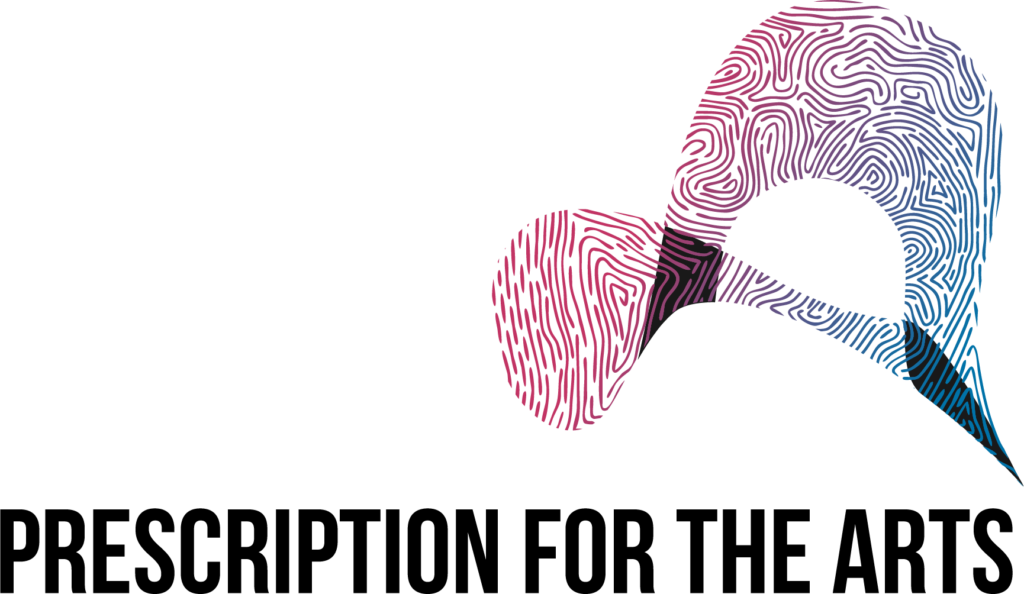healing through arts experiences

1 in 5 U.S. adults experience mental illness each year
1 in 20 U.S. adults experience serious mental illness each year
1 in 6 U.S. youth aged 6-17 experience a mental health disorder each year
50% of all lifetime mental illness begins by age 14, and 75% by age 24
Suicide is the 2nd leading cause of death among people aged 10-14
– From the National Alliance on Mental Illness
“Our definition of mental health is not solely about the absence of mental illness, but about helping us cope with the everyday stresses of life, raising our capabilities and skills, being more productive, and contributing to community and connection. And yes, celebrating moments of joy.
Carl Jung once said that loneliness is not the absence of people but the inability to express what matters to you most. Finding that expression with words, or—when words fail—with a movement, a sound, or the framing of an image, triggers biochemical responses that generate connection and pleasure and awe, and it helps us find meaning and perspective. This allows us to create a pathway when we may have felt the future was uncertain.
In fact, I would go further. Creative expression is not merely a mechanism to achieve better health. It is intrinsically part of our human nature, as fundamental as breathing and walking and speaking, and as such, it is a fundamental part of health.
Because in the end, health is not about merely surviving. It is about thriving.”
– Christopher Bailey
Arts and Health Lead
World Health Organization
Co-Founder, Jameel Arts & Health Lab
ABOUT
Prescription for the Arts is a program modeled on ‘Arts on Prescription: A Field Guide for US Communities’ created by Mass Cultural Council – Center for Arts in Medicine in Florida. The program is one of partnerships between healthcare providers, social care providers, school social care providers and local arts, culture and nature organizations in order to connect clients with resources that support their short and long-term health needs. Health care and social care providers are enabled to prescribe arts, culture, or nature experiences to support clients’ health and well-being. This type of program is grounded in evidence that engaging with arts, culture and nature has positive impacts on mental and physical health, social connection and overall quality of life.
CORE VALUES
Prescription for the Arts leads with the values of equity and inclusion by creating safe, equitable and anti-racist programs and spaces with a focus on the community. The program will serve under or un-insured, underserved, low income, marginalized, Disabled, and Black and Brown people and communities. The program will ensure that end users are recognized as leaders and core participants throughout the planning and design process.
HISTORY
Arts on Prescription has been used for around two decades in the United Kingdom as part of broader social prescribing schemes. Individuals who present to their primary care doctor with nonmedical problems (e.g. social isolation or loneliness, which is the case in 20–30% of all visits to doctors in the United Kingdom) or who require additional psychosocial support for their health can be referred to a link worker. Link workers connect patients with community activities, including participatory arts activities. Local evaluations in different regions have shown benefits for mental health, chronic pain, management of complex and long-term conditions, social support and well-being.
Work at local levels is supported by the Social Prescribing Network, which has regional representatives to support programs, and provides resources and support with evaluation . NHS England (United Kingdom) has focused on social prescribing as a key component of plans to provide universal personalized care, giving patients choice and control over their mental and physical health care including (for some people) a personal health budget. Further, in 2019, the United Kingdom Government announced funding for 1300 more link workers to help the spread of the program nationwide and formally included social prescribing with contracts for family doctors.
The projected goal for 2023 was to have 4000 link workers in place and to refer 900 000 people to social prescribing schemes.
HOW IT WORKS
Health care providers assess whether a patient or client could benefit from arts, culture or nature-based activities. The provider then writes a prescription for a specific experience or activity, which refers the client to a ‘care coordinator.’ The care coordinator connects with patients and clients to determine their interests in the arts and connect them with arts, culture and nature partners. Prescriptions have expiration dates to help incentivize clients to take advantage of these programs.
Prescriptions are written with the following information:
Dose: amount of each specific activity or experience
Duration: overall period of time one receives the dose (single does, two weeks, six months)
Frequency: how often the activity or experience takes place (every day, twice a week, once a month)
Refills: Patients who have found success need to check in with their provider to refill a prescription.
Participants should be active participants in deciding dose, duration and frequency. Clients can opt to bring up to 3 additional family/caregiver participants to their prescribed activities.
THE NEED
The practice of cultivating well-being is not functionally prioritized in US medical systems. For individuals, the participation in the arts and culture-based activities has been shown to reduce loneliness, isolation, and symptoms of depression and anxiety and to positively impact well-being, attention, cognition, a sense of purpose or achievement, and meaningful relationships. It has also been shown to support physical health: stimulating movement, easing pain, and improving mobility, sleep, coordination, and balance.
For communities, Prescription for the Arts can foster social connectedness and community engagement; support local arts, culture, and nature assets; and increase the cultural responsiveness of health and social care practices. More broadly, Prescription for the Arts can contribute to health equity goals by increasing access to the health benefits of arts, culture, and nature. That said, a common benefit of arts, culture, and nature experiences is that, unlike most medications, they are capable of addressing several health needs at a time. For example, a dance class that is prescribed to help support cardiovascular health may also support new friendships, self-efficacy, and reduced anxiety.
PARTNERS
Organizations/Populations Served: Addiction offices, Autism Society, Advocates, Horizons, Casey’s Pond, The Haven, Pediatricians Offices and Medical Offices, Routt County Council on Aging, School Districts.
Arts: Opera Steamboat, Steamboat Art Museum,, Steamboat Dance Theatre, Steamboat Creates, Piknik Theatre, Colorado New Play Festival, Wildhorse Movie Theater, Perry-Mansfield Performing Arts School & Camp, Scott Goodhart’s Dancing and Movement classes, Yampa Valley Choral Society, Strings Music Festival, Steamboat Symphony Orchestra, Bud Werner Memorial Library, Off the Beaten Path Bookstore, Ceramics/Pottery
Heritage: Tread of Pioneers Museum, Museum of NW Colorado, Hayden Heritage Center, Tracks and Trails Museum of Oak Creek & Phippsburg
Community: Community Center of Hayden, Community Center of Oak Creek
Nature: Botanic Gardens, Yampatika, Stagecoach Stage Park, Steamboat Lake State Park
WRAP-AROUND SERVICES
Transportation: Secure local drivers to transport participants as needed.
Food: Local restaurants are paid to provide meals to those engaging in activities right after work or at lunch.
Language Barriers: These need to be addressed at all levels of the program with translators available at the programs.
Daycare: Daycare or child care services are provided to single parents or guardians can participate in the program.
IMPACT
Impact: surveys are conducted at the time of in-take by the care coordinator, with check-in calls throughout the prescription and a final interview conducted at the completion of the program. Surveys will also be made available on-line for those wishing to provide anonymous results. Surveys are conducted with clients, health and mental care providers and arts and nature organizations to assess the effectiveness of the program, barriers to access, challenges and successes.
Benefits for Providers extend beyond patients to care providers. “It feels like you can give something to people and…it makes people happy,” said one physician. “I feel like we don’t do a lot of making people happy in medicine.”
Benefits for Patients: Health benefits have emerged from short-term interventions (e.g., listening to relaxing music for 20 minutes or writing for 15 minutes a day over several days), as well as from longer-term interventions (e.g., theater, dance, or art classes that recur over several weeks or months)
Proven Results: An adaptation of Prescription for the Arts, Art Pharmacy, found that, of the people who initially fill their prescription, 73% stick with it throughout the six months. In fact, 91% of these patients request a “refill” so that they can continue. Participants report a 22% improvement in emotional well-being, and 9 out of 10 report that they’re likely to recommend their care provider to others based specifically on the provider’s participation in the Art Pharmacy program.
DETAILS
Cost: Low to no cost. Care providers communicate in an initial session the on-going costs of the programs if the client or patient wishes to continue programming beyond the prescription.
Populations: Care coordinators will be specific to certain populations such as adolescents, aging adults or individuals with mental health concerns or physical disabilities.
Communication: Common language needs to be established with care providers in order to allow them to discuss the program with patients. This language extends to care coordinators and arts and cultural organizations participating in the program.
Marketing: Creation of logo and tagline for visual branding. Website created with opportunities to participate in the program in multiple languages assisted by Integrated Community.
Staff: Care providers will be trauma informed and educate all participating organizations in trauma response. From the first interaction to the last, the program will be inclusive, welcoming and safe for clients. This begins with signage and aides to help clients find their way at new activities and feel welcome. Videos will be created around language, coping with trauma and setting expectations so all participating organizations, providers and coordinators speak the same language and have the same understanding of the program.
Communication: Have open and consistent avenues for discussion and collaboration between cultural organizations and health care providers. Surveys will be shared with health care providers so that ongoing conversations can guide the future of the program. Care coordinators notify health care providers when patients access the arts/culture resource that was prescribed and share surveys.
Locations: Some activities can take place on-site at schools, care provider offices or mental health care provider offices.
Marketing: Public awareness of the program will increase legitimacy for the program. Website will help healthcare providers understand the health benefits of the program. Prescription for the Arts will normalize arts and cultural engagement for cultures that do not typically participate in these activities (ranching, agriculture). Marketing program includes creating a community-referral network for those wanting to participate.
Longevity/Scalability of the program: Create database of providers, experiences they provide, costs, time of day, etc. Create employee manual so if there is staff turnover, there is a framework for someone new to step into without interrupting the program. Launch initial pilot with UC Health Pediatrics to ensure the process is smooth before launching the program throughout NW Colorado.
*This program was designed using Arts on Prescription: A Field Guide for US Communities compiled by Mass Cultural Council: Center for Arts in Medicine, University of Florida. Authored by: Tasha L. Golden, PhD; International Arts + Mind Lab, Johns Hopkins Medicine;
University of Florida Center for Arts in Medicine
Amy Bantham, DrPH; Move to Live More
Keely Mason, MA; International Arts + Mind Lab, Johns Hopkins Medicine;
University of Florida Center for Arts in Medicine
Jill Sonke, PhD; University of Florida Center for Arts in Medicine; EpiArts Lab
Käthe Swaback, MA, ATR; Mass Cultural Council
Maria Nagae Kuge; University of Florida Center for Arts in Medicine
Alyson Maier Lokuta; New Jersey Performing Arts Center
Josh Caven; Harvard University
Mridula (Mally) Shan; Harvard University
Ryan Clinesmith, MFA; Harvard University
Kirsten Keene, MA; University of Florida Center for Arts in Medicine
Nico Manhas; University of Florida Center for Arts in Medicine



